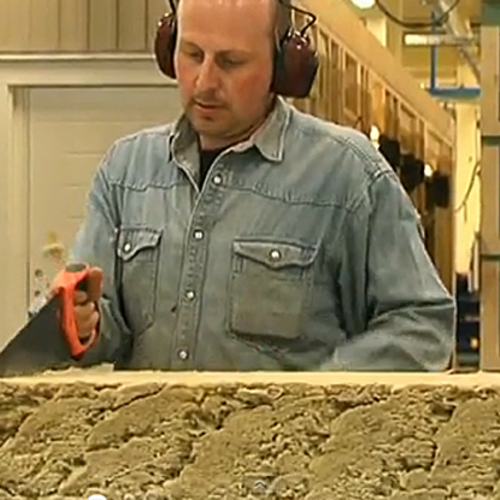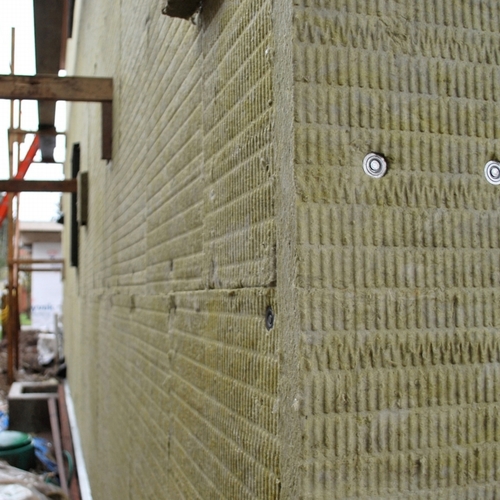
I had an interesting meeting recently with a group of gentlemen who plan to distribute lambs’ wool insulation imported from New Zealand. Their company, Lambsulation, is gearing up to distribute throughout the US. They contacted me to get my impressions of their product and how they might effectively market it to the green building community. I know that wool is a good insulator. As a kid at sleep-away camp, I clearly remember having to wear wool sweaters that made my skin itch when camping, so we would stay warm in case we got wet. So why not use it for thermal insulation in a house?
At the meeting was Stephen Fookes, their New Zealand representative and Chairman of the National Council of New Zealand Wool Interests. I was told that he knows more about wool than anyone. He was clearly knowledgeable and passionate about it, and gave me enough information to make my eyes glaze over. According to their information, wool has an R-value of 3.37 per inch, has virtually no embodied energy in manufacture, and the fire and insect resistant additives are all non-toxic, although I don’t have specific information on them. They claim it doesn’t settle like cellulose and fiberglass, but I will wait to see some proof on that. One interesting tidbit I learned was that this product is not made from the shearing of live sheep, in fact it is removed chemically from the hides of organic lambs that were slaughtered for meat. Not being a vegetarian, this doesn’t bother me, but it might cause others to pause before using it.
The insulation is available in both batts and loose fill, which is applied with standard equipment used for fiberglass. According to their reports, the insulation fibers absorb moisture into their cores when relative humidity exceeds 65%, while keeping the exterior of each fiber dry at all times. This sounds like an interesting benefit, but I wonder about the value. Regardless, from the standpoint of performance and environmental impact, wool insulation seems like a reasonable choice.
Will people buy it?
Down to the business of our meeting. These guys wanted to know what I thought of their product and if they could pick up enough of the market to make it a viable alternative. Their cost structure may be as much as twice that of cellulose and fiberglass, which offer roughly the same basic performance. Wool certainly does have some benefits over the competition, but I think they will have a limited market unless they can really spur consumer demand, not unlike companies like Icynene have successfully done. Wool has some green street cred – low embodied energy, low toxicity, renewably harvested insulation sure seems appealing, but how many people will be willing to pay a premium for something that they can’t show off. Too bad they don’t make kitchen counters out of the stuff.
Weekly Newsletter
Get building science and energy efficiency advice, plus special offers, in your inbox.















14 Comments
To funny
LOL - tweets like this sure won't help them...
@greencurmudgeon New blog post - Poor little lambchop skinned by evil New Zealanders to insulate homes: http://tinyurl.com/2fugknw
I can think of a few champions for their product - we will just have to leave poor little lambchop out of the equation though
Tweet
But if it gets people to read my blog, who's complaining.
Impractical
It's a sweet, romantic thought to insulate with wool--but at double the cost of cellulose for similar or slightly lesser performance, as well as similar environmental & health footprints? I just don't see it getting beyond a boutique-type market. Cellulose is where it's at for insulation... and wool for socks & sweaters.
Impractical
Sometimes we need to look beyond first cost. I'm not advocating for wool over any other insulation, but rather hoping that we will consider things other than the almighty dollar.
No embodied energy perhaps in
No embodied energy perhaps in the manufacturing process, but the product certainly contains embodied energy if it comes from New Zealand.
I don't know Carl, I think I'll stick with cellulose.
Embodied Energy
I did say that it has virtually no EE in manufacture. I realize that there is transportation energy involved, but if it is shipped by boat, that energy involved is quite low. There is a parallel in the hothouse flower industry. From what I understand, the amount of energy required to raise flowers in cold climates generally exceeds the transportation energy required to deliver flowers that are raised in tropical climates that otherwise require no heating during the growing process. Until we see complete Life Cycle Analysis on a wide range of products, we can only make our best judgements on the total energy involved in manufacture and delivery of different products.
Not only transportation
Not only transportation energy, but the impact of raising the livestock if this were to drive demand beyond current lamb production. Using the wool of lambs raised for meat is a great idea, but it seems there is a higher and better use for wool: clothing. If what is said above about cellulose being half the cost of wool is true, then I don't know why anyone would choose wool. Since cellulose is recycled, it would be cheaper, lower impact, and have similar/same performance; the clear choice. That said, not being a rational choice does not prevent a product from being successful.
US made?
Do we have enough sheep here to produce enough of a product to make such a venture worthwhile? That would sure lower the cost, would it not? How about other countries? Maybe these cats would be better off exporting their KNOWLEDGE to countries that have lots of sheep.
US wool insulation
There actually are some US made sheep's wool insulation products already on the market through Black Mountain Insulation USA (formerly Sayrco)
http://www.blackmountaininsulationusa.com
I assume they are somehow connected to the similarly named Black Mountain Insulation Ltd in the UK which also sells sheep wool insulation products, but don't know this for sure.
They are manufactured in SE Pennsylvania, though I don't know from where or how the wool is originally sourced. There is a fair amount of sheep raised - for meat, wool, and to aid in rotational grazing - in NE PA where the company is headquartered , and I know a few years ago at least the market was constantly glutted, so they might just be taking advantage of that.
We bought a couple batts earlier in the year to play around with. They were similar to cellulose in R-value but a lot pricier. They were also not as dense and so floppier (which made them more difficult to work with in stuffing stud bays, but sometimes easier in stuffing other random spaces).
Certainly worth keeping an eye on. I'm particularly interested in the "SheepRock" panels (also sold as "WeKa" panels in parts of Europe) - semi-rigid insulation panels with R-value of 6.5/inch, though last time I checked in they still weren't being actively produced.
Buy US products
Why would anyone want to buy from outside the country when we have plenty of available wool in the US? Sounds like another new business starting that wants to make another country richer instead of helping our own poeple in need!
I think the product would work but it sounds like it is too expensive and like was said earlier, why spend more money than is necessary on a product you can't even show off to your friends??
Support the US and save money - buy US cotton that is a green product and less expensive.
chemical exposure
I'm interested in wool batts, not to decrease energy consumption, but because I don't want toxic chemicals in my home. How can one make an argument about "health footprints" (above) when the effects of the chemicals we are bombarded with constantly aren't really known and are difficult to study? Taking these out of the home where possible sounds like a good place to start.
WEKA panels found
Hi, a quick search found WEKA panels and WEKA blocks produced with US wool available through Good Shepherd Wool out of Interlaken NY (goodshepherdwool.com). It's pretty interesting. One advantage that is not considered enough is that wool has excellent fire resistance abilities - in addition to its non-toxic properties.
Better,Safer,Smarter and Easier to install Wool Insulation
A few facts to clear up some earlier comments from others. Most of the scrap Cotton comes from blue jean manufactures located in Mexico and shipped to the USA. Put a match to your blue jeans and daily newspaper (cellulose) and see how fast they burn up. They are both heavily treated with chemicals to avoid this. Wool does not burn,Believe me I tried to do it with a blow torch. The reason it takes at least 38% oxygen. You are only breathing 24%. All of the wool used in insulation is waste wool. There is no commercial use for clothing. There is a market being created in the USA for this material normally discarded. About price $$, I can sell you a bottle of cheap wine for a dollar or some real vintage top shelf stuff for a lot more money. Both will get you drunk but quality , value, is the point you are obviously missing. Have you ever seen the quality of this product ? http://www.blackmountaininsulationusa.com
Domestic sheep's wool insulation product
Just learned of this Oregon company: http://www.oregonshepherd.com/
from this Jetson Green post: http://www.jetsongreen.com/2011/02/natural-wool-insulation-oregon-shepherd.html
Is apparently made from their own (live, I assume??) sheep in Oregon, and can be loose-filled. Now I'm a little more curious about this idea for cases where someone might not want cellulose for whatever reason... hmm.
Log in or create an account to post a comment.
Sign up Log in